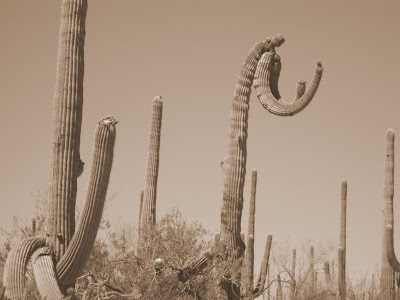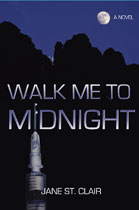By Jane St. Clair
The other day it rained in the Sonoran desert. It took perhaps a month to build up to it; the desert is not a place for rain.
The sun shines 360 days a year, it hardly ever rains. Desert rain comes inbetween great lengths of sun; waiting for rain is like walking on pebbles that are too far apart.
Without rain, the plants in the desert grow brown. They lose their tops first — their tops shrivel up and fall off and then the whole plant goes into shock and struggles to survive. The big saguaro cactus turn into drying watermelons; the paws of the prickly pear go from thick and chubby and childlike, to old and dry and thin.

Meanwhile, the sun keeps shining in its fake-friendly way, forcing the animals into panic. They drink every bit of standing water left; when that disappears, they suck water from cactus; when that dries up, they must go without water. Snakes, lizards, turtles – they are the most fortunate because they can go without drinking for the longest time. The liquids in their bodies become so concentrated as to be poison. The mammals –bobcat, pack rat and coyote — are less fortunate. A local mountain lion, so desperate for water, comes to a children’s park to drink from the swimming pool.
A terrible tension builds up in the desert as the plants struggle against wilting, drying and premature death, and as the animals slow themselves down to survive. There is no water, no water anywhere. Arizona has great beds of dry sand where rivers can run, and long stretches of dry creeks that run from the mountaintops to the valleys, but they run dry between rains.

Then one day, the storm begins to spin itself! Big dramatic white clouds take days and days to form in the clear turquoise sky like the overture of a grand symphony.The Navajo call the spirit of rain Yei. On his body are bars of rain, on his wings hang bags of water, his legs are dark clouds, his hands and feet are lightning. At first Yei brings his gifts slowly, gently.
Then the whiteness turns strange unearthly colors: –grey, black, blue, pink, orange– like a horrible gigantic bruising wound in the heavens.

Thunder roars – something has to let loose and something must crash and shake down the sky! there’s too much tension! So it rains, how it rains, rain like you’ve never seen before!
The people of the Tohono T’oham Nation, the Native American people here, say the desert smells like rain. Now as the desert rain comes down in great solid sheets of water, it does. The desert has the musty odor of wet creosote, and it smells like rain.
Then two great arcs of color form over the Catalinas: a double rainbow: red, yellow, blue, violet. Bright light of color, lighting the soft pastels of the desert into the colors of jewels: emerald, citrine, ruby, sapphire.
 The riverbeds fill up and develop currents that drown automobiles and people. The little dry creeks run again.
The riverbeds fill up and develop currents that drown automobiles and people. The little dry creeks run again.
It’s dark and very cold for us outside, but we run out barefoot anyway to see the desert rain. Everyone is out for the party – bobcat, snake, lizard, coyote, puma – everyone’s out for a drink – just because it rained.

